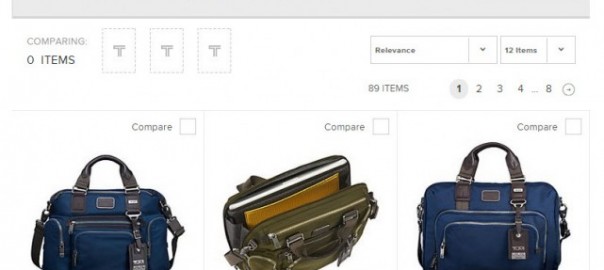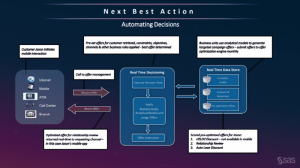Perhaps the most surprising thing Tumi learned is that men window-shop.
Not on the street, mind you, but online. “The analytics show men are spending time, going through the navigation rather than the search,” said Naveen Gunti, senior director of global e-commerce technology and operations at Tumi Holdings Inc., the worldwide maker of premium luggage. “That is rather surprising to me. I thought, ‘Men don’t do window shopping,’ but I see that happening online. I see them engaging.”

As the owner of several Tumi luggage pieces, purchased both online and in-store, I myself am a little surprised by this revelation. Do I window-shop online? Whether I do or not, the behavior is one of several discoveries almost a year after the company adopted new in-house tools to optimize its online experience.
The services, through Adobe, provide a combination of interactive visuals and analytics that are helping Tumi get its products online faster while also revealing surprising ways in which its customers shop online.
The result is significantly longer engagement times and expedited entries into new channels, notably mobile. The initiative has also taught Tumi an important lesson about understanding its market, and one that would benefit any retailer: Like that long-ago postcard in the zipper pocket, some of the most valued findings can emerge from unexpected places.
Such behavioral findings could also contribute to higher sales in other channels, notably the store. Almost 90 percent of global consumers (88 percent) have said they use the Internet to research online and purchase offline, according to 2014 research by DigitasLBi. More specific to Tumi – 45 percent of luxury purchases are influenced by what the customer has read or found digitally, according to a 2015 report by WBR Digital.
Sizing up the challenge
Tumi is not a newcomer to online retailing, but the rapid-evolving pace of digital commerce requires pretty much any merchant to view the industry with regularly refreshed eyes.
This was especially the case as Tumi tried to keep up with its own product innovation. The company, which normally offers about 3,000 products, introduces 1,500 new items a year. Every one of those items needs to be photographed, edited and resized, described in detail and loaded to the website.
The trick: Tumi has just three months to do that before the product is in the warehouse.
Rushing the process through its third-party supplier, however, was not so easy a solution. The Tumi brand is synonymous with quality – its bags are known for rugged fabrics, patented closure system, ID locks and aircraft-grade aluminum tubing. Its customers pay a premium because they expect the best, and that experience should begin on the website.
A couple of chintzy images won’t cut it. Waiting to load better visuals, however, meant lost sales opportunities.
Making a case in-house
Tumi decided to take the work in-house. It turned to Adobe for a suite of technologies, which include a web content management system and user analytics.
Among the immediate results, Tumi realized it could load all videos, images (including detailed shots of products both inside and out) and zoom features 30 percent to 40 percent faster. The added capabilities and time freed it to add new features, including an interactive service through which online customers could overlay monograms onto images of luggage and experiment with different colors and font styles.
Other benefits since the launch, in October 2014, include:
Extended engagement: On average, session times increased by 40 percent, indicating customers are spending more time exploring and learning about products. This in turn has led to higher purchase rates, though Gunti cautioned that conversions from shopping to buying are influenced by several factors.
Unexpected taxonomies: Tumi shifted its focus to navigation and narrowed the number of products it lists per category to make it easier for users. “We basically track the journey of the customer,” Gunti said. “How they move back and forth on the site and what they are looking at.” Among the unexpected results was the window-shopping lesson.
Rapid mobile: Another unforeseen finding is that Tumi’s customer base is shifting from desktop to mobile much faster than expected. “We will be focusing more on mobile based on that,” Gunti said. “That’s a huge one for us, at least for the rest of the year.”
Better social sharing: Through Adobe’s social platform service, which is tightly integrated with its analytics, Tumi is able to better manage its social media channels globally. It can, for example, localize various campaigns based on successes – a campaign that excels in North America can be adapted for its UK market.
Packing for the future
With its first full year on the updated platform almost zipped up, Tumi is casting its digital eye on new horizons.
The luggage maker is, for example, working on a portal for its retail partners and distributors. Through it they will have faster access to the latest versions of Tumi’s online visuals and other assets, so they can enrich the brand experience on their own sites. Presently Tumi supplies the images to these parties through burned CDs or file transfers.
Tumi also plans to further personalize the customer experience, based on its analytics, to include individualized recommendations. Once complete, Shopper A, upon visiting the home page, may see an image of the Vapor Lite extended-trip packing case, to complement her Vapor Lite continental carry-on. Shopper B, meanwhile, could see an Alpha Bravo backpack because he had previously shopped the Mission sling.
And who knows? The further personalized recommendations could lead to additional unexpected findings. The more information Tumi collects, the more it learns, and the greater its opportunities for controlling its destiny.
As Gunti put it: “The data collection and the kind of slicing and dicing of information is what I feel is very powerful.”
This article originally appeared on Forbes.com, where Bryan serves as a retail contributor. You can view the original story here.
Digital & Social Articles on Business 2 Community(191)
Report Post









